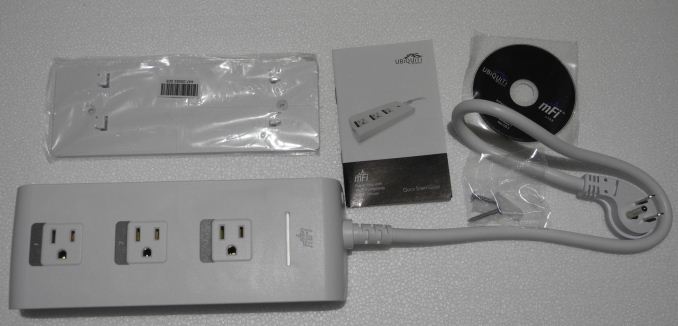Ubiquiti Networks mFi mPower Wi-Fi Power Strip Review
by Ganesh T S on November 21, 2013 3:00 AM EST- Posted in
- Home Automation
- Wi-Fi
- Ubiquiti Networks
- IoT
Setup and Usage Impressions
The UFO Power Center caught our fancy because power consumption measurement is something we do for almost all products that we review. Using a Kill-a-Watt is not very accurate, while the Watts Up? meters are very costly for our particular purpose. The UFO Power Center is continuing to serve us well. However, with more devices being tested simultaneously, and lab space at a premium, we started looking for something more down to earth in terms of industrial design. The mPower Pro fit our needs perfectly, but Ubiquiti was having some supply issues when we were looking for a unit to test out. In the end, we landed up with the mPower 3-outlet version.
Hardware
The mPower unit comes with a wall mounting plate, screws, a CD with the mFi software and a quick start guide along with the main unit. From the outside, it looks every bit like a conventional power strip. In addition to the circuit breaker reset button on the side, it also has a factory reset button. A flashing LED on the front panel provides status information.
Setup Process
The setup process for the mPower is quite similar to that of the UFO Power Center. When powered up, the device creates an ad-hoc wireless network. Upon connecting a PC to the ad-hoc network, the unit's web UI is accessible. The browser interface allows for selecting and entering credentials for the Wi-Fi network to which the unit is supposed to connect. Our mPower unit was originally running firmware version 1.2.3 , but upgrading to 2.0.7 brought a lot of interesting features.
The firmware update could be processed only after linking up the mPower unit with a mFi controller instance. The mFi is a Java-based software which proved very difficult to install on my Windows 8 machine. It also got complicated a bit because I had mFi installed on multiple computers on the same network (not the usual scenario for most end-users). I eventually got it working on a Windows 7 setup. The default credentials for the unit are printed on the box (ubnt/ubnt). However, linking the unit to a mFi instance overrides these credentials with those used for the mFi.
Using the mPower
The controller software is a full-fledged automation suite with support for rules and other features. It will not be covered in detail because this review is about the mPower unit specifically. Suffice to say that all the parameters of the mPower unit (names and status of the outlets, power consumption recording etc.) can be viewed, recorded, used for rules and altered as applicable through the mFi interface.
The browser interface for the mPower in the firmware version 1.2.3 was minimal and only provided statistics related to the network connection and some logs related to it. In 2.0.7, the Controls tab was introduced and this provides a way for users to control outlet status and check up on the instantaneous values of the electrical parameters (as shown in the gallery above).




























61 Comments
View All Comments
bznotins - Tuesday, December 10, 2013 - link
So I ordered this from Amazon and have been generally impressed. A few problems, though, one which is quite ironic.The ironic one first. One of the reasons I bought this tool to help measure my power usage and ultimately reduce it. My home server is basically a Win8.1 box with TeamViewer access. It remains on 24/7 (except for the once a month when it hard locks and I have to power-cycle it, which is the other reason for this mFi power bar). Anyways, my home server generally uses 30W at idle. The simple act of installing the Win8 mFi home server software pushes the CPU utilization up so that it's no longer in low-power idle and my server consumes 60W (as measured by the same power bar, heh). So just tracking my power using the server doubles the consumption of my home server.
Thankfully the mFi server software can be shut down so that it doesn't run 24/7 and the power bar can still be accessed via its IP. And it works great in that case. Easy to turn each outlet off if necessary both from LAN and WAN (using port forwarding on my router).
My other problem with the unit is that it is connected to my home network AND broadcasting its unsecured adhoc network at the same time. There is no apparent way to disable the latter once the former is running. I thought that it would be automatic. In fact, I didn't think it was possible for the device to be connected to my home network and broadcasting an adhoc network simultaneously, but it is. I plan to mess with this further as the device isn't terribly friendly to novices like me.
Overall I'm happy because it does what I need it to, but there are still some issues.